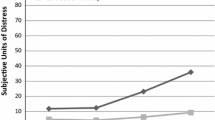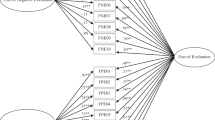Abstract
Previous research suggests that individuals with high levels of social anxiety (SA) tend to make negative interpretations of ambiguous social situations but fail to make positive interpretations of such situations. These biases have been shown to occur at both faster (more immediate) and slower (more reflective) levels of processing. Fears of evaluation may play a role in the tendency of individuals with SA to exhibit interpretation biases. As an extension of previous research, we examined the unique variance accounted for by fear of negative evaluation (FNE) and fear of positive evaluation (FPE) in the relationship between SA and interpretation biases, using a paradigm that collected both reaction time and self-report data. FPE accounted for significant variance in the relationship between SA and negative interpretation bias at a faster level of processing (reaction time measure). However, neither FNE nor FPE accounted for significant variance in the relationship between SA and negative interpretation bias at a slower level of processing (self-report measure). Our findings suggest that FPE may play an important role in biased interpretations during more immediate processing, whereas SA may be broadly influential for biased interpretations during more reflective processing.
Similar content being viewed by others
Notes
Additional issues related to the reaction time and endorsement rate measures of interpretation biases through the WSAP are addressed in the “Discussion” Section.
A full list of the word-sentence pairs used in the modified WSAP is available upon request.
References
Alden, L. E., Taylor, C. T., Mellings, T. M. J. B., & Laposa, J. M. (2008). Social anxiety and the interpretation of positive social events. Journal of Anxiety Disorders, 22, 577–590. doi:10.1016/j.janxdis.2007.05.007.
American Psychiatric Association. (2013). Diagnostic and statistical manual of mental disorders (5th ed.). Arlington, VA: American Psychiatric Publishing.
Amir, N., Beard, C., & Bower, E. (2005). Interpretation bias and social anxiety. Cognitive Therapy and Research, 29, 433–443. doi:10.1007/s10608-005-2834-5.
Amir, N., Beard, C., & Przeworski, A. (2005). Resolving ambiguity: The effect of experience on interpretation of ambiguous events in generalized social phobia. Journal of Abnormal Psychology, 114, 402–408. doi:10.1037/0021-843X.114.3.402.
Amir, N., & Bomyea, J. (2010). Cognitive biases in social anxiety disorder. In S. G. Hofmann & P. M. DiBartolo (Eds.), Social anxiety: Clinical, developmental, and social perspectives (pp. 373–393). New York: Academic Press.
Amir, N., Foa, E. B., & Coles, M. E. (1998). Negative interpretation bias in social phobia. Behaviour Research and Therapy, 36, 945–957. doi:10.1016/S0005-7967(98)00060-6.
Amir, N., Prouvost, C., & Kuckertz, J. M. (2012). Lack of a benign interpretation bias in social anxiety disorder. Cognitive Behaviour Therapy, 41, 119–129. doi:10.1080/16506073.2012.662655.
Amir, N., & Taylor, C. T. (2012). Interpretation training in individuals with generalized social anxiety disorder: A randomized controlled trial. Journal of Consulting and Clinical Psychology, 80, 497–511. doi:10.1037/a0026928.
Beard, C., & Amir, N. (2008). A multi-session interpretation modification program: Changes in interpretation and social anxiety symptoms. Behaviour Research and Therapy, 46, 1135–1141. doi:10.1016/j.brat.2008.05.012.
Beard, C., & Amir, N. (2009). Interpretation in social anxiety: When meaning precedes ambiguity. Cognitive Therapy and Research, 33, 406–415. doi:10.1007/s10608-009-9235-0.
Carleton, R. N. (2012). The intolerance of uncertainty construct in the context of anxiety disorders: Theoretical and practical perspectives. Expert Review of Neurotherapeutics, 12, 937–947. doi:10.1586/ERN.12.82.
Carleton, R. N., Collimore, K. C., Asmundson, G. J., McCabe, R. E., Rowa, K., & Antony, M. M. (2009). Refining and validating the Social Interaction Anxiety Scale and the Social Phobia Scale. Depression and Anxiety, 26, E71–E81. doi:10.1002/da.20480.
Carleton, R. N., Collimore, K. C., McCabe, R. E., & Antony, M. M. (2011). Addressing revisions to the Brief Fear of Negative Evaluation Scale: Measuring fear of negative evaluation across anxiety and mood disorders. Journal of Anxiety Disorders, 25, 822–828. doi:10.1016/j.janxdis.2011.04.002.
Clark, D. M. (2001). A cognitive perspective on social phobia. In W. R. Crozier & L. E. Alden (Eds.), International handbook of social anxiety: Concepts, research, and interventions relating to the self and shyness (pp. 405–430). New York: Wiley.
Fergus, T. A., Valentiner, D. P., McGrath, P. B., Stephenson, K., Gier, S., & Jencius, S. (2009). The Fear of Positive Evaluation Scale: Psychometric properties in a clinical sample. Journal of Anxiety Disorders, 23, 1177–1183. doi:10.1016/j.janxdis.2009.07.024.
FluidSurveys. (2013). FluidSurveys [Online Survey Software]. Available from http://www.fluidsurveys.com.
Gilbert, P. (2001). Evolution and social anxiety: The role of attraction, social competition, and social hierarchies. Psychiatric Clinics of North America, 24, 723–751. doi:10.1016/S0193-953X(05)70260-4.
Hayes, A. F. (2013). Introduction to mediation, moderation, and conditional process analysis. New York: The Guilford Press.
Heimberg, R. G. (1994). Cognitive assessment strategies and the measurement of outcome of treatment for social phobia. Behaviour Research and Therapy, 32, 269–280. doi:10.1016/0005-7967(94)90121-X.
Heimberg, R. G., Brozovich, F. A., & Rapee, R. M. (2014). A cognitive-behavioral model of social anxiety disorder. In S. G. Hofmann, & P. M. DiBartolo (Eds.). Social anxiety: Clinical, developmental, and social perspectives (3rd edn., pp. 705–728). Waltham, MA: Academic Press. doi:10.1016/B978-0-12-394427-6.00024-8
Hirsch, C., & Mathews, A. (1997). Interpretive inferences when reading about emotional events. Behaviour Research and Therapy, 35, 1123–1132. doi:10.1016/S0005-7967(97)00069-7.
Hirsch, C. R., & Mathews, A. (2000). Impaired positive inferential bias in social phobia. Journal of Abnormal Psychology, 109, 705–712. doi:10.1037/0021-843X.109.4.705.
Hofmann, S. G. (2007). Cognitive factors that maintain social anxiety disorder: A comprehensive model and its treatment implications. Cognitive Behaviour Therapy, 36, 193–209. doi:10.1080/16506070701421313.
IBM Corp. (2012). IBM SPSS statistics for windows, version 21.0. Armonk, NY: IBM Corp.
Leary, M. R. (1983). A brief version of the Fear of Negative Evaluation Scale. Personality and Social Psychology Bulletin, 9, 371–375. doi:10.1177/0146167283093007.
Mahoney, A. E., & McEvoy, P. M. (2012). Changes in intolerance of uncertainty during cognitive behavior group therapy for social phobia. Journal of Behavior Therapy and Experimental Psychiatry, 43, 849–854. doi:10.1016/j.jbtep.2011.12.004.
Maxwell, S. E., & Cole, D. A. (2007). Bias in cross-sectional analyses of longitudinal mediation. Psychological Methods, 12, 23–44. doi:10.1037/1082-989X.12.1.23.
Morrison, A. S., & Heimberg, R. G. (2013). Social anxiety and social anxiety disorder. Annual Review of Clinical Psychology, 9, 249–272. doi:10.1146/annurev-clinpsy-050212-185631.
Moser, J. S., Hajcak, G., Huppert, J. D., Foa, E. B., & Simons, R. F. (2008). Interpretation bias in social anxiety as detected by event-related brain potentials. Emotion, 8, 693–700. doi:10.1037/a0013173.
Murphy, R., Hirsch, C. R., Mathews, A., Smith, K., & Clark, D. M. (2007). Facilitating a benign interpretation bias in a high socially anxious population. Behaviour Research and Therapy, 45, 1517–1529. doi:10.1016/j.brat.2007.01.007.
Preacher, K. J., & Hayes, A. F. (2008). Contemporary approaches to assessing mediation in communication research. In A. F. Hayes, M. D. Slater, & L. B. Snyder (Eds.), The Sage sourcebook of advanced data analysis methods for communication research (pp. 13–54). Thousand Oaks, CA USA: Sage Publications Inc.
Reilly, A. R., Carleton, R. N., & Weeks, J. (2012). Psychometric evaluation of the Social Interaction Phobia Scale. Anxiety, Stress & Coping: An International Journal, 25, 529–542. doi:10.1080/10615806.2011.598150.
Rodebaugh, T. L., Heimberg, R. G., Brown, P. J., Fernandez, K. C., Blanco, C., Schneier, F. R., & Liebowitz, M. R. (2011). More reasons to be straightforward: Findings and norms for two scales relevant to social anxiety. Journal of Anxiety Disorders, 25, 623–630. doi:10.1016/j.janxdis.2011.02.002.
Rodebaugh, T. L., Weeks, J. W., Gordon, E. A., Langer, J. K., & Heimberg, R. G. (2012). The longitudinal relationship between fear of positive and negative evaluation. Anxiety, Stress, & Coping, 25, 167–182. doi:10.1080/10615806.2011.569709.
Schneider, W., Eschman, A., & Zuccolotto, A. (2002). E-prime user’s guide. Pittsburgh: Psychology Software Tools Inc.
Sluis, R. A., & Boschen, M. J. (2014). Fear of evaluation in social anxiety: Mediation of attentional bias to human faces. Journal of Behavior Therapy and Experimental Psychiatry, 45, 475–483. doi:10.1016/j.jbtep.2014.06.007.
Staugaard, S. R. (2009). Reliability of two versions of the dot-probe task using photographic faces. Psychology Science, 51, 339–350.
Stopa, L., & Clark, D. M. (2000). Social phobia and interpretation of social events. Behaviour Research and Therapy, 38, 273–283. doi:10.1016/S0005-7967(99)00043-1.
Vancleef, L. M. G., & Peters, M. L. (2008). Examining content specificity of negative interpretation biases with the Body Sensations Interpretation Questionnaire (BSIQ). Journal of Anxiety Disorders, 22, 401–415. doi:10.1016/j.janxdis.2007.05.006.
Vassilopoulos, S. P. (2011). Interpretation bias for facial expressions in high and low socially anxious individuals: Effects of stimulus duration. Hellenic Journal of Psychology, 8, 44–65.
Waechter, S., Nelson, A. L., Wright, C., Hyatt, A., & Oakman, J. (2014). Measuring attentional bias to threat: Reliability of dot probe and eye movement indices. Cognitive Therapy and Research, 38, 313–333. doi:10.1007/s10608-013-9588-2.
Wallace, S. T., & Alden, L. E. (1997). Social phobia and positive social events: The price of success. Journal of Abnormal Psychology, 106, 416–424. doi:10.1037/0021-843X.106.3.416.
Wang, W., Hsu, W., Chiu, Y., & Liang, C. (2012). The hierarchical model of social interaction anxiety and depression: The critical roles of fears of evaluation. Journal of Anxiety Disorders, 26, 215–224. doi:10.1016/j.janxdis.2011.11.004.
Weeks, J. W. (2010). The Disqualification of Positive Social Outcomes Scale: A novel assessment of a long-recognized cognitive tendency in social anxiety disorder. Journal of Anxiety Disorders, 24, 856–865. doi:10.1016/j.janxdis.2010.06.008.
Weeks, J. W., Heimberg, R. G., Fresco, D. M., Hart, T. A., Turk, C. L., Schneider, F. R., & Liebowitz, M. R. (2005). Empirical validation and psychometric evaluation of the Brief Fear of Negative Evaluation scale in patients with social anxiety disorder. Psychological Assessment, 17, 179–190. doi:10.1037/1040-3590.17.2.179.
Weeks, J. W., Heimberg, R. G., & Rodebaugh, T. L. (2008a). The Fear of Positive Evaluation Scale: Assessing a proposed cognitive component of social anxiety. Journal of Anxiety Disorders, 22, 44–55. doi:10.1016/j.janxdis.2007.08.002.
Weeks, J. W., Heimberg, R. G., Rodebaugh, T. L., Goldin, P. R., & Gross, J. J. (2012). Psychometric evaluation of the Fear of Positive Evaluation Scale in patients with social anxiety disorder. Psychological Assessment, 24, 301–312. doi:10.1037/a0025723.
Weeks, J. W., Heimberg, R. G., Rodebaugh, T. L., & Norton, P. L. (2008b). Exploring the relationship between fear of positive evaluation and social anxiety. Journal of Anxiety Disorders, 22, 386–400. doi:10.1016/j.janxdis.2007.04.009.
Weeks, J. W., & Howell, A. N. (2012). The bivalent fear of evaluation model of social anxiety: Further integrating findings on fears of positive and negative evaluation. Cognitive Behaviour Therapy, 41, 83–95. doi:10.1080/16506073.2012.661452.
Weeks, J. W., & Howell, A. N. (2014). Fear of positive evaluation: The neglected fear domain in social anxiety. In J. W. Weeks (Ed.), The Wiley-Blackwell handbook of social anxiety disorder (pp. 433–453). New York: Wiley.
Winton, E. C., Clark, D. M., & Edelmann, R. J. (1995). Social anxiety, fear of negative evaluation and the detection of negative emotion in others. Behaviour Research and Therapy, 33, 193–196. doi:10.1016/0005-7967(94)E0019-F.
World Medical Association. (2013). World Medical Association Declaration of Helsinki: Ethical principles for medical research involving human subjects. Journal of the American Medical Association, 310, 2191–2194. doi:10.1001/jama.2013.281053.
Acknowledgments
We wish to thank Justin W. Weeks, who commented on an earlier draft of this manuscript.
Conflict of interest
M. Taylor Dryman and Richard G. Heimberg declare that they have no conflict of interest.
Informed consent
All procedures followed were in accordance with the ethical standards of the responsible committee on human experimentation (national and institutional). Informed consent was obtained from all individual subjects participating in the study.
Animal rights
No animal studies were carried out by the authors for this article.
Author information
Authors and Affiliations
Corresponding author
Rights and permissions
About this article
Cite this article
Dryman, M.T., Heimberg, R.G. Examining the Relationships Among Social Anxiety, Fears of Evaluation, and Interpretation Bias. Cogn Ther Res 39, 646–657 (2015). https://doi.org/10.1007/s10608-015-9694-4
Published:
Issue Date:
DOI: https://doi.org/10.1007/s10608-015-9694-4




